How to plant tomato and pepper transplants
/Two of the most popular transplants are peppers and tomatoes. These tips will help ensure that you have healthy, growing plants.
Read MoreTwo of the most popular transplants are peppers and tomatoes. These tips will help ensure that you have healthy, growing plants.
Read MoreHere is an all new list of varieties that work well in small spaces. The varieties we chose this year not only provide delicious edibles, they also look lovely and will brighten up small spaces.
Read MoreWe have literally thousands of tomato varieties to choose from here, we grow and taste hundreds every year, so if a staffer is picking one as their favorite, you know it has to be good!
Read MoreThe ballots are in… Igleheart Yellow Cherry Tomato was selected as the best tasting tomato at Seed Savers Exchange in 2015!
Read MorePrince George of Cambridge has been big news this past year, and so have our seeds in this royal collection! Just in time for the royal wedding anniversary, we've compiled a list of our most royally-named heirloom, organic, and open-pollinated varieties. Every seed we preserve is special in its own right, but these are sure to make your garden fit for a king or queen.
Read MoreThe time has come to get your tomato plants started so they're ready to transfer outside once the warm weather officially settles in. Take a look at this winter's top ten favorite heirloom tomato varieties and let them inspire your upcoming garden.
Read MoreEver wonder about the names of your favorite heirloom tomatoes? Some names are rather descriptive of the color, shape, or place they came from (Hungarian Heart, Green Sausage, Wapsipinicon Peach), others just make you scratch your head (Mortgage Lifter), and still others are equally descriptive and curious (Hillbilly Potato Leaf, Trucker's Favorite). We put together a guide for you to have some fun and figure out what your heirloom tomato name could be!
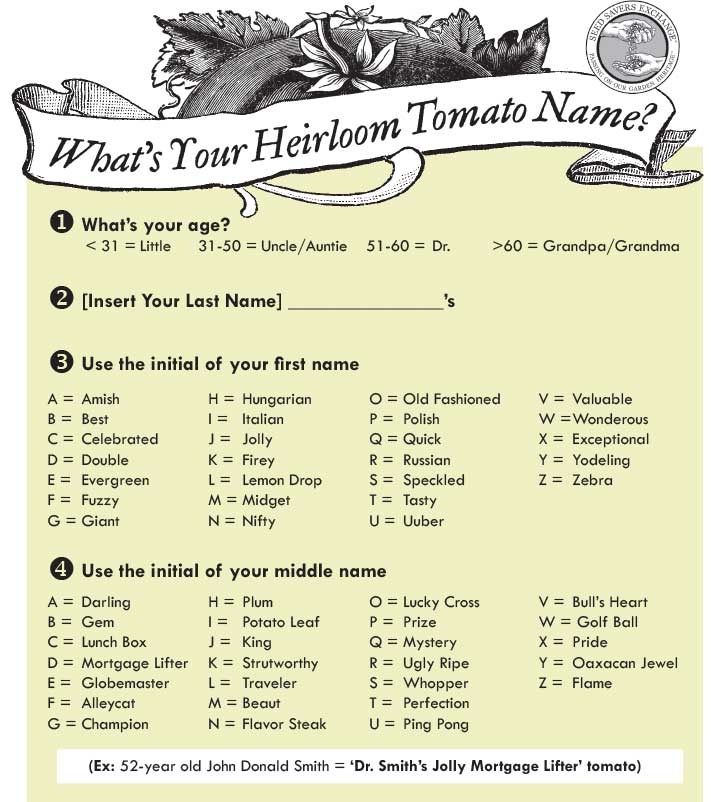
(click here to view the 1700 comments from our Facebook followers!)
___________________________________________________________________
Seed Savers Exchange is a non-profit organization located in Decorah, Iowa, with a mission to conserve and promote America's culturally diverse but endangered garden and food crop heritage for future generations by collecting, growing, and sharing heirloom seeds and plants.
Despite concerns that our tomatoes would not ripen in time for the event, over 40 heirloom and open-pollinated tomato varieties (and one mega-mart hybrid tomato) competed for the title of this year's favorite. SSE staff, friends, and family brought tomatoes from gardens across northeast Iowa and Wisconsin to serve over 800 event attendees.
Read More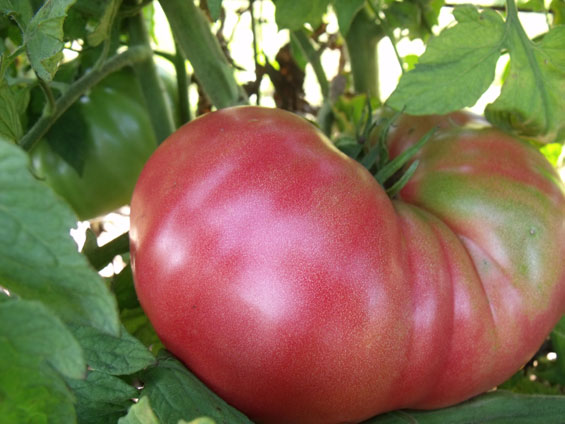
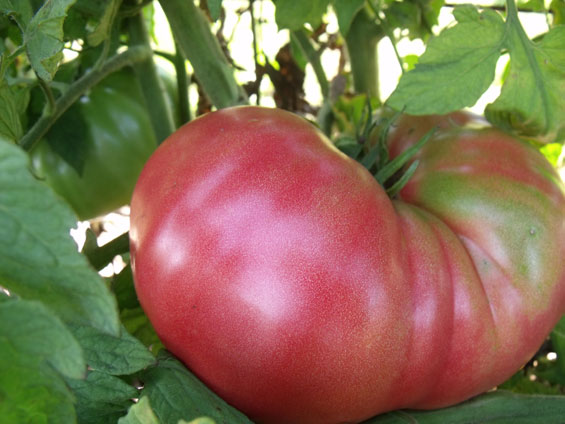 The ‘Dester’ took home the blue ribbon at the 6th Annual Tomato Tasting and Seed Saving Workshop at Heritage Farm last weekend. With over 40 varieties in the lineup, the competition was steep for this year’s unlikely winner.
The ‘Dester’ took home the blue ribbon at the 6th Annual Tomato Tasting and Seed Saving Workshop at Heritage Farm last weekend. With over 40 varieties in the lineup, the competition was steep for this year’s unlikely winner.
The ‘ Dester’ tomato was something of a Cinderella story from the SSE trial gardens. Every year our commercial crew grows out a number of new varieties from the collection or from member-growers to discover new offerings for the SSE catalog. This year a champion was born! The ‘Dester’ is a large, full-flavored, pink beefsteak tomato. It was the first tomato on the sampling line, yet the flavor stuck in visitors’ minds when it came time to cast their vote—more than 40 tomato samples later.
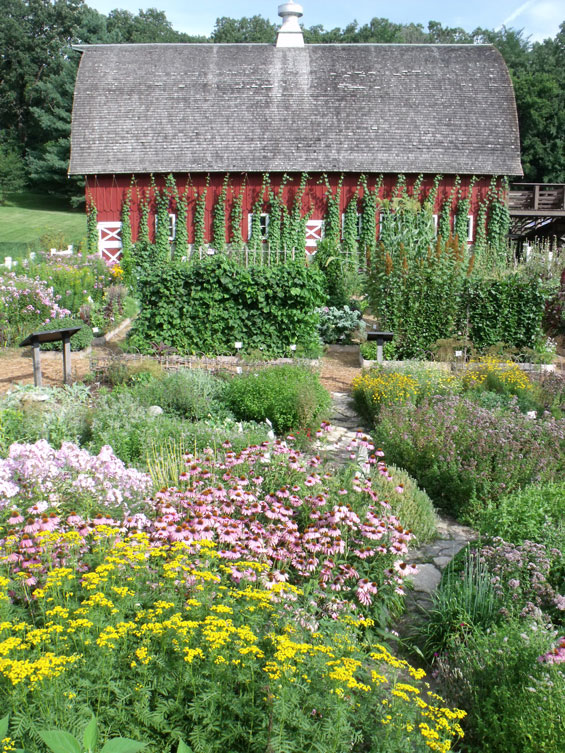 Other top finishers included last year’s favorite, ‘Lemon Drop,’ a small yellow-green cherry tomato with a sweet—almost tart—flavor, and ‘Black Sea Man,’ a Russian heirloom with brownish-pink fruit and full-bodied or “complete” flavor, as one participant put it. The salsa tasting line featured 14 homemade recipes. Ironically, the blue ribbon went to Anne Sheahan’s Mango Salsa, proving the eclectic pallets of this year’s voters. (We’ll try to get the heirloom tomato version of the recipe for next year!)
Other top finishers included last year’s favorite, ‘Lemon Drop,’ a small yellow-green cherry tomato with a sweet—almost tart—flavor, and ‘Black Sea Man,’ a Russian heirloom with brownish-pink fruit and full-bodied or “complete” flavor, as one participant put it. The salsa tasting line featured 14 homemade recipes. Ironically, the blue ribbon went to Anne Sheahan’s Mango Salsa, proving the eclectic pallets of this year’s voters. (We’ll try to get the heirloom tomato version of the recipe for next year!)
Visitors passed through the display gardens snapping pictures of the towering, 10-foot-tall ‘Hot Biscuits’ amaranth, and the barn wall completely covered in ‘Grandpa Ott’s’ morning glory on their way to seed saving workshops.
SSE tomato advisor Craig LeHoullier was back by popular demand to provide a personal and passionate introduction to the cult of the heirloom tomato, including a list of the tomatoes he would choose to be stranded with on a desert island. (In case you’re wondering, or planning for a "three-hour tour," his list included ‘Cherokee Purple,’ ‘Lucky Cross,’ and ‘Cherokee Chocolate’.)
Craig’s talk was followed by a lively question and answer session, which gave him a chance to show off his encyclopedic knowledge of heirloom tomatoes and their histories. He even managed to dispel a few myths before breaking for a trip through the tomato tasting line. (Don’t believe the hype, says LeHoullier there’s no such thing as a low-acid or disease-resistant tomato!)
“The joy of gardening is that there are no absolutes,” said LeHoullier before prompting the crowd for their favorite qualities of heirloom tomatoes.
Meanwhile SSE staff led a hands-on workshop on saving tomato seeds.
“One thing I try to remember when saving seed at home is that I don’t need 100 fruit to get started,” said workshop facilitator and SSE Horticultural Technician Gabi Masek. “Two to five is really all you need!”
The workshop covered everything first-time seed savers would need to know to start saving their own seed, including ideas of what to do with extra seeds, like trying a home germination test.
While the adults took notes at the workshops and tasting tables, the kids displayed the fun factor of heirloom tomatoes with a tomato toss and ketchup-making activity led by SSE Display Gardener Grant Olsen.
“I already have a few ideas of how to make the tomatoes a little sloppier for next year’s toss,” said Olsen with a grin.
Whether you were tasting, tossing, or taking notes, we hope everyone walked away from this year’s Tomato Tasting and Seed Saving Workshop with a little inspiration for their own gardens.
And if you missed the event, here are a few tomato seed saving tips to help you get get started:
In nature, ripe tomatoes fall from the plant and slowly rot exposing the seeds, allowing natural weathering to break down the slimy gelatinous coating on the seed. This is easily replicated through the process of fermentation. To save tomato seed, seed savers must deliberately remove the coating from the tomato seed. Here’s how:
But don’t forget to follow the most important rule: Put a label on everything, every step of the way. Because in the words of our collection curator, “No one wants to plant something, thinking they have one variety and end up with something else.”
Note from a seed saver: Tomatoes will, most commonly, self-pollinate, so seeds saved will remain ‘true to type’ without worrying about cross-pollination. However, there are always exceptions. Some tomatoes can cross pollinate, this is dependent on many factors such as flower shape, environment, and biodiversity. To ensure seed purity you may want to plant only one variety or spread different varieties throughout your garden.

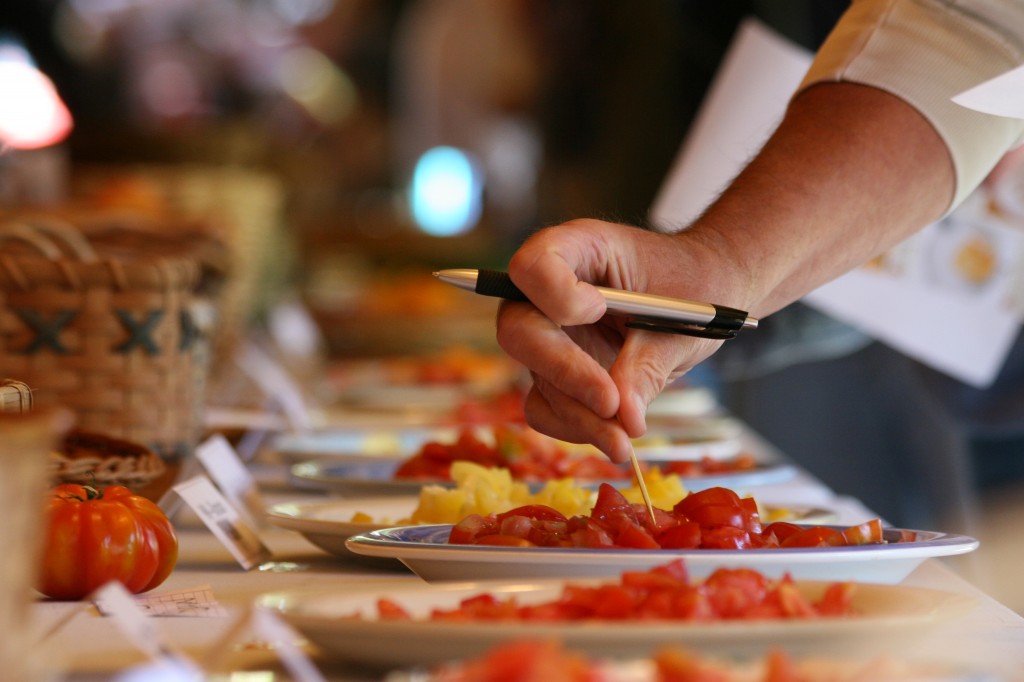 Ok, we have a secret; it’s in the public’s best interest that we come clean with this information. We at Seed Savers Exchange have ulterior motives behind the upcoming Tomato Tasting and Seed Saving Workshop at Heritage Farm on September 3rd.
Ok, we have a secret; it’s in the public’s best interest that we come clean with this information. We at Seed Savers Exchange have ulterior motives behind the upcoming Tomato Tasting and Seed Saving Workshop at Heritage Farm on September 3rd.
If you’ve been to the Tomato Tasting in years past, you know that (on the surface at least) this event is a celebration—a festival of flavors, colors, textures, shapes and sizes. In fact, this year visitors will have a chance to sample 40 to 50 different varieties of heirloom tomatoes, ranging from yellow cherry tomatoes to pink beefsteaks and striped stuffing tomatoes. However, we’ve heard from a reliable informant that there will also be a few “new” varieties in the lineup—that is, varieties not currently offered in the Seed Savers Exchange Catalog—or any seed catalog for that matter. This year’s Tomato Tasting will, in fact, feature a few varieties from the SSE collection. Not only do these “trial” varieties keep regular visitors to our Tomato Tasting on their toes, they also represent a critical aspect of SSE’s preservation work.
Many of the varieties in our collection are rare. Offering them in the catalog is a way of introducing them to the public—and more importantly, the food supply. Here’s how the process of selecting “new” heirloom varieties occurs:
Each year SSE’s Preservation garden crew grows out accessions from our collection to regenerate seed. During this time Preservation staffrecord vegetative characteristics, evaluate the quality and quantity of fruit, and save enough seed to preserve in our long-term storage facilities.
Towards the end of the growing season, SSE staff, local market gardener Eric Sessions, and Board Member David Cavagnaro, tour the preservation gardens looking for stand-out varieties. These stand-out varieties are then grown for further evaluation by the Commercial garden crew the following season.
Here’s an example: ‘Emmy’, show-stopping yellow tomato without any signs of blemish, was grown in 2010. We hoped the history of this variety was as good as the tomato, and then we read the donation letter:
October 20, 2005
Dear Seed Savers Exchange,
My friend Emmy was born in Transylvania which used to belong to Hungary. At the end of WW II she was expelled (she was of German descent) and had to leave her house. As she left in the fall of 1945, she grabbed a tomato, managed to keep it throughout the arduous journey into Germany and kept planting the seeds of her Transylvanian tomato.
I met Emmy in 1978 in Rosenheim, Germany and when we left in 1979, Emmy gave me some seeds of her Transylvanian tomato. I have planted this tomato every year, first in Eugene, Oregon and then in Tigard, Oregon. The tomato is yellow, does not grow very large (at least in my garden) and has a very intensive tomato flavor. If you wish, you may name the tomato Emmy!
- Ernestine Bloomberg
“New" or “trial” varieties making an appearance in this year’s Tomato Tasting include the ‘Strawberry’ as well as the ‘Emmy’ tomatoes, both of which are not currently commercially available. However, with your help, that could soon change. We hope you’ll join the conspiracy by attending this year’s tasting and telling us what you think of each variety. Your opinion, and vote, will help us determine the lineup for future catalog offerings!
Browse tomato varieties from the SSE catalog in our online store Learn more about the SSE Yearbook Learn more about SSE preservation
Seed Savers Exchange is a nonprofit, member supported organization that collects, preserves and shares heirloom seeds for our future. Since 1975, SSE and our supporters have collected the seeds and stories that would otherwise have been lost.











Seed Savers Exchange is a tax-exempt 501(c)3 nonprofit organization dedicated to the preservation of heirloom seeds.
Seed Savers Exchange
3094 North Winn Road
Decorah, Iowa 52101
Send Us A Message
(563) 382-5990
Customer Service Hours:
Monday to Friday, 9am - 5pm CST
© 2020 Seed Savers Exchange